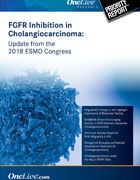Publication
Article
Special Issues
Infigratinib Active in Intrahepatic Cholangiocarcinoma
Author(s):
The selective pan-FGFR kinase inhibitor infigratinib showed meaningful antitumor activity and a manageable safety profile in patients with previously treated intrahepatic cholangiocarcinoma who harbor FGFR2 fusions.
Milind Javle, MD
The selective pan-FGFR kinase inhibitor infigratinib (BGJ398) showed meaningful antitumor activity and a manageable safety profile in patients with previously treated intrahepatic cholangiocarcinoma (IHC) who harbor FGFR2 fusions, according to updated phase II findings presented at the 2018 ESMO Congress.
In the trial of 71 patients with FGFR2 fusions or translocations (NCT02150967), the confirmed and unconfirmed overall response rate (ORR) in all FGFR2-fusion—positive patients was 31.0% (95% CI 20.5%-43.1%) and the investigator-assessed confirmed ORR in patients with potential for confirmation was 26.9% (95% CI 16.8%-39.1%).
Approximately 13% to 17% of patients with IHC have FGFR fusions, and the majority of the patients enrolled on the trial were female (62.0%) as opposed to male (38.0%). These patients received the ATP-competitive, FGFR1—3-selective oral TKI infigratinib at 125 mg daily for 21 days of a 28-day cycle. Treatment was discontinued if there was unacceptable toxicity, disease progression, investigator discretion, or withdrawal of consent.
Partial responses were confirmed in 18 patients (25.4%), and stable disease was confirmed in 41 patients (57.7%). Progressive disease was observed in 8 patients (11.3%), and there were 0 confirmed complete responses. Tumor response was assessed per RECIST v1.1 criteria using CT or magnetic resonance imaging.
“The vast majority of patients either have response or stable disease. The disease control rate was 80%, so that is quite remarkable for a targeted therapy in this disease,” said lead author Milind Javle, MD, professor, Department of Gastrointestinal Medical Oncology, Division of Cancer Medicine, The University of Texas MD Anderson Cancer Center, in an interview with OncLive. “Currently, this is the largest trial of patients with FGFR fusions, and it also has the longest follow-up.”
Secondary endpoints of disease control rate (DCR), median duration of response (DoR), progression-free survival (PFS), and overall survival (OS) were reported for patients with potential for confirmation. In these patients, DCR was 83.6% (95% CI, 72.5%-91.5%), median duration of response was 5.4 months (95% CI, 3.7-7.4), median PFS was 6.8 months (95% CI, 5.3-7.6), and median OS was 12.5 months (95% CI, 9.9-16.6).
Patients with potential for confirmation were defined as those who completed or discontinued treatment prior to 6 cycles. The endpoints in this population were investigator-assessed.
Safety and pharmacokinetics were also evaluated at secondary endpoints in all patients. Adverse events (AEs) were observed during treatment and for the following 30 days after last dose. Toxicity was manageable with phosphate binders and routine supportive care, investigators noted. Prophylactic use of a phosphate-binding agent was recommended by investigators on the days in which infigratinib was administered. Patients were also instructed to follow a low phosphate diet.
The most common treatment-related AEs (TRAEs) of any grade were hyperphosphatemia (73.2%), fatigue (49.3%), stomatitis (45.1%), alopecia (38.0%), constipation (35.2%), dry eye (32.4%), and dysgeusia (32.4%). Fifty-seven patients (66.2%) experienced grade 3/4 TRAEs, the most common of which were hypophosphatemia (14.1%), hyperphosphatemia (12.7%), hyponatremia (11.3%), and stomatitis (9.9%).
“This study has taught us a lot about this disease,” Javle said. “First, [it taught us] that FGFR fusions occur in 15% of patients, but more so in the younger population and often in women. These patients do benefit with targeted FGFR inhibition.”
These findings suggest that infigratinib induces clinically meaningful activity in patients with FGFR2-fusion IHC when given following chemotherapy. Additionally, investigators noted that the findings of this study support FGFR2 as a therapeutic target for this patient population. Investigators concluded that further investigation of infigratinib is warranted.
“The next step here is to see whether we can expand this experience in the first-line setting, where this drug can be given upfront without chemotherapy. I believe that the efficacy will be seen in the first-line setting as well,” Javle suggested.
Javle M, Kelley RK, Roychowdhury S, et al. A phase II study of infigratinib (BGJ398), an FGFR-selective tyrosine kinase inhibitor (TKI), in patients with previously-treated advanced cholangiocarcinoma containing FGFR2 fusions. In: Proceedings from the 2018 ESMO Congress; October 19-23, 2018; Munich, Germany. Abstract 3652.








%20u.jpg?fit=crop&auto=format)

